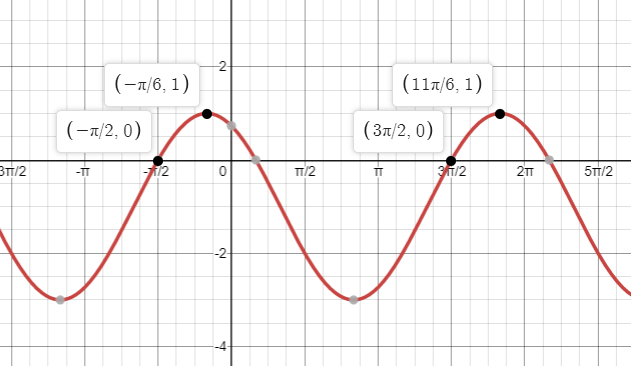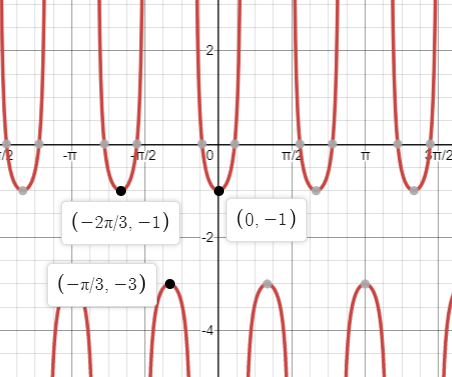convert 135o to radians. Give your answer in terms of pi
(3pi)/4
Period of sinx
2pi
range of y = 4sin(x - pi/2)
-4<=y<=4
In which quadrants is cosecant (csc) positive?
Quadrant 1 and Quadrant 2 (same place sin is positive)
simplify cotxsecx
cscx
Angle of
(16pi)/3
Find a coterminal angle between 0 and
2pi
(4pi)/3
Range of secx
y <=-1 uu y >=1
give three asymptotes of y = cot(x/2)
... ,-4pi, -2pi, 0, 2pi, 4pi, 6pi, ...
Which quadrant has cosx < 0 and cotx > 0?
Quadrant 3
Convert -3 radians to degrees
-171.89o
Find the reference angle for
(16pi)/3
pi/3
Asymptotes between -2pi and 2pi for tanx
-3pi/2, -pi/2, pi/2, 3pi/2
Range of y = 5tan(3x - pi/6) + 4
All real numbers
If cos u = 1/3 and tan u < 0, find the value of u in degrees. Round to two decimal places
cos-1(1/3) = 70.53o but tan < 0 so should be in quadrant 4.
reference angle 70.53o
actual angle u = 360 - 70.53 = 289.47o
Find sinx and tanx if cosx = -3/5;
pi < x< (3pi)/2
sinx = -4/5 and tanx = 4/3
Find the arc length: Circle with radius of 20 feet. Central angle of 75o. Round to two decimal places if needed.
1. convert 75o to radians
2. s =
r*theta = (5pi)/12 * 20
Answer: 26.18 feet
What's the difference between tanx and cotx graphs?
tanx goes up, cotx goes down.
tanx goes through (0,0). cotx has an asymptote at x = 0
Write a sin equation for the graph below

y = -2sin(x-pi/3)-1
If cotx = -3 and sinx > 0, then secx = ?. Round to two decimal places
cotx < 0 and sinx>0 means x is in quadrant 2 and secx < 0
cotx = -3 --> tanx = -1/3 --> tan-1(-1/3) =-18.43o
Reference angle = 18.43.
sec(18.43) 1/cos(18.43) = 1.05 but said in quadrant 2, secx is negative
final answer: - 1.05
sqrt(3)sectheta + secthetacottheta=0
theta = (5pi)/6 or (11pi)/6
A wind machine used to generate electricity has blades that are 10 feet in length. The propeller is rotating at four revolutions per second. Find the linear speed, in feet per second, of the tips of the blades.
1. convert from revolutions per second to radians per second (because revolutions isn't an exact distance)
4rev/sec * 2pi rad/rev = 8pi rad/sec
2. v = rw
v = 10 * 8pi = 80pi feet/sec
3. Round to 251.33 feet/sec
What's the difference between secx and cscx graphs?
cscx has an asymptote at x = 0.
secx has a y-intercept at x = 0 (y = 1)
Write a sec equation for the graph below

y = sec(3x) - 2
2sin^2x + 3sinx + 1 = 0
factor to get sinx = -0.4 or -1 . . . so
x = (7pi)/6, (11pi)/6, or (3pi)/2
write a cosine function that has a midline of 2, amplitude of 3, period of 1 and a phase shift of 1/4 to the left.
f(x) = 3cos(2pi(x+1/4))+2